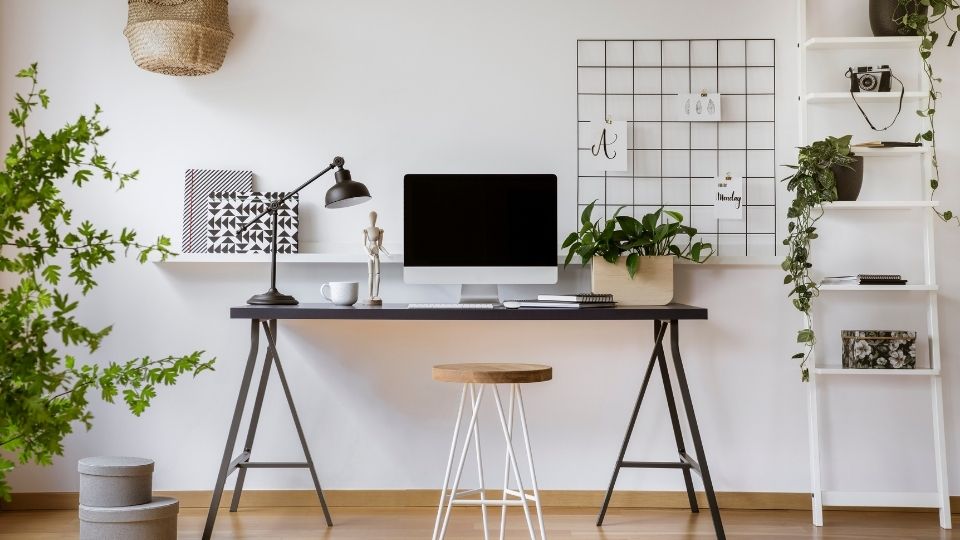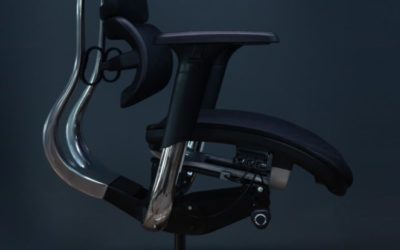How to Make Your Home Office More Ergonomic
We get asked a lot about creating ergonomic workplaces. I’ve been helping people for decades to create a comfortable and biomechanically correct workspace. I believe that there are ten components that you should consider to make the perfect home office.
As a general rule, an ergonomic office chair with lumbar support and armrests, an adjustable desk, and an eye-level monitor are three items you should have in your home office. An external mouse and keyboard provide a better range of motion and good ergonomic support.
In this article, I will present a complete step-by-step guide to creating your ergonomic office. Planning for your home office and following these tips will pay dividends to avoid distractions and achieve a healthy work-life balance. Building an ergonomic home office is an investment in your well-being and health. By incorporating some of these terrific tips and following some valuable guidelines, you will be able to overcome any home office challenges.
Ergonomists Tips
I reached out to a top ergonomist in Ireland, Niamh Pentony of Boyne Ergonomics and she shared her advice on Making Your Home Office More Ergonomic with me:
- To reduce the risk of developing musculoskeletal pain at the DSE workstation, you need to ensure that firstly, you are positioned at the correct height for the work surface and secondly, the equipment is positioned correctly for you and your needs.
- Start with your position relative to your surface. I always advise using the elbows as the guide for seated height. If you have a horizontal line from your elbow to your hand when they are on your mouse and keyboard when your shoulders are relaxed, you are the correct height for your surface. Make sure you have support underfoot if you cannot plant your heel on the floor at this seated height.
- Building from there, look at your monitor position. You want it to be high enough that you can see the whole screen when you sit upright against your chair and look straight ahead with a relaxed neck. I use the internet address bar as my guide for monitor positioning. However, for those that use bifocal or varifocal lenses, the screen may need to be lower and tilted back slightly to reduce “chin lift” when reading the screen.
- Keep your keyboard and mouse close enough so they can be used with your shoulders relaxed and elbows at your sides. Anything else you use frequently should be within easy reach.
- IMO positioning is only half the battle to reduce musculoskeletal pain. Mobility is the key and I know I have seen the effects of reduced mobility on homeworkers this last year or so, including in employees with good ergonomic home office setups.
10 Tips to Create a Successful Ergonomic Home Office:
1. Choose a Dedicated Space
You may be fortunate enough to have a free unused room utilised as a dedicated office space. However, if space is tight, you need to think creatively about your home office.
Many of us utilise the kitchen as our office space. However, this is not ideal due to too many distractions and clearing your office before every meal. Therefore, you may have to think outside the box about using what space. Try unused areas in quiet rooms, or even a large closet may do the trick! If you use a touch of creativity, you will discover a space to convert into your home office.
2. Invest in a Decent Office Chair
A proper office chair is one of the best assets you can have for your home office. You will be spending a significant amount of time sitting, so you need to get this right. It’s essential to have a home office chair that maintains optimal spinal alignment to ensure excellent posture.
There are countless sorts of ergonomic chairs usable in the home office. No one type of home office chair is necessarily the best, but some components are paramount to look for. The following items should be considered for ultimate comfort:
- Seat height– Your home office chair seat elevation1 should be freely adjustable. A gas shock control is the simplest means to do this. A typical office chair seat height ranges from 40 to 60cm off the floor. If this range doesn’t work for you, you can easily purchase the perfect gas shock for your height and body weight. All you will need is a rubber mallet to tap off the connecting chair base and seat pan to replace your new gas shock.
- Seat depth and width. The seat size should have adequate space to support you comfortably.2 Typically, the width of 50cm is the norm. The distance from the front to the back of your seat should be enough so that you can sit with your spine against the back of your chair while leaving roughly 8cm between the seat and back of your knees.
- Lumbar support. Your chair should have lumbar support and should fit comfortably.
- Back of Chair. The back of your home office chair should be 30-50cm wide. Your back should be adjustable in elevation and must have a back tilt angle. It should be able to support your mid and lower spine with adequate support 3 of the lumbar region (again). The back should be adjustable to go forward and back and must have a locking device to protect it from going too far back.
- Office Chair Fabric. The office chair seat and back fabric should be flexible to increase the surface area between your buttocks and fabric. An increased surface area will disburse your weight load better and will make your seat more comfortable to sit on for extended periods. Having a ‘breathable’ fabric is always better than stiffer surfaces.
- Armrests. Yes, you should have armrests, and they should be adjustable. They should allow the user’s arms and shoulders to be more relaxed. Remember to keep your elbows at your side while using your home office chair.
- Swivel. Your home chair should easily rotate so that you integrate movement and make reaching for objects much more manageable.
3. Get the Right Desk
After your home office chair is sorted, you will want to obtain a desk that fits your budget and space. Try to find a desk that promotes your productivity by helping you remain comfortable throughout the day.
Standing desks are the latest trend. However, you cannot merely substitute sitting with standing—ideally, a combination of sitting and stand works best.
4. Monitor Height Position
For optimal eye health, you will want to keep your screen at eye level. For proper eye health, attempt to Apply the ’20-20-20 principle’:
- Every 20 minutes of screen time…
- You should rest for about 20 seconds and…
- Look at something that is 20 feet away.
If you are employing more than one monitor, make sure that they are all at the same elevation and preferably the same variety of monitors.
5. Support Your Feet
Give your legs plenty of room. Your feet also should be comfortable and flat on the floor. Remove any cords or clutter under your table.
Dedicate storage spaces for your files, documents, and other supplies, and don’t store them under your desk.
6. Have Good Lighting
Lighting and temperature are often neglected when setting up a home office. Inadequate lighting may cause you to strain your eyes, resulting in headaches and fatigue, which may reduce your productivity.
Strive to obtain as much sunlight as possible. If natural light isn’t feasible, it may be a great idea to invest in full-spectrum lighting. It is always good to use indirect light, though, to prevent glare on your screen.
7. Mouse and Keyboard
The mouse and keyboard play a vital role in enhancing your efficiency and comfort. Mechanical keyboards are the most comfortable. The mouse should be larger than average. Always avoid small travel mice as they are uncomfortable for extended use. Ensure that both your mouse and keyboard are detachable so you can find the ultimate comfortable position for yourself.
8. Add Some Plants
Several plants will not only brighten your office but may enhance your air quality as well. The best plants for the home office are spider plants and ferns because they are easy to care for and are renowned for their air filtering characteristics.
9. Keep Your Office Clean
We tend to overlook cleaning when you’re not used to working alone at home. A clean office will aid in your productivity, and it makes your home office more enjoyable.
10. Maintain Office Hours
Even though you can work anytime you want, it’s always a good idea to pattern regular office hours if you’re going to optimise productivity. Working for a fixed period gives your day structure. Alongside enhancing productivity, it’s also helpful to strike a balance as well. So, take periodic breaks throughout your day so you can incorporate more movement.
Final Thoughts
By following my advice today, I’ve helped countless people avoid back pain issues by setting up an ergonomic home office. By implementing these simple changes to your sitting environment, you should experience long-lasting benefits.
It is important to remember that we usually conform to the workstation rather than making it work for you. An uncomfortable chair, an incorrectly positioned monitor, and an inefficient desk height may result in physical discomfort.
It is, therefore, vital to make sure your home office is ergonomically sound. What you must remember is that unconsciously complacent movements will eventually lead you to break down. If you stay active and aware throughout the day, you should avoid pain and develop lasting good posture habits.
Last, of all, I’d like to thank Niamh Pentony for sharing her wisdom in this article.
Sources
- Demura S, Yamada T. Height of Chair Seat and Movement Characteristics in Sit-to-Stand by Young and Elderly Adults. Perceptual and Motor Skills. 2007;104(1):21-31. doi:10.2466/pms.104.1.21-31
- Avindra S. Goonetilleke, Song Feizhou, A methodology to determine the optimum seat depth, International Journal of Industrial Ergonomics, Volume 27, Issue 4, 2001, Pages 207-217,
- Man-Machine-Environment System Engineering, 2016, Volume 406; ISBN : 978-981-10-2322-4; Yifeng Du






